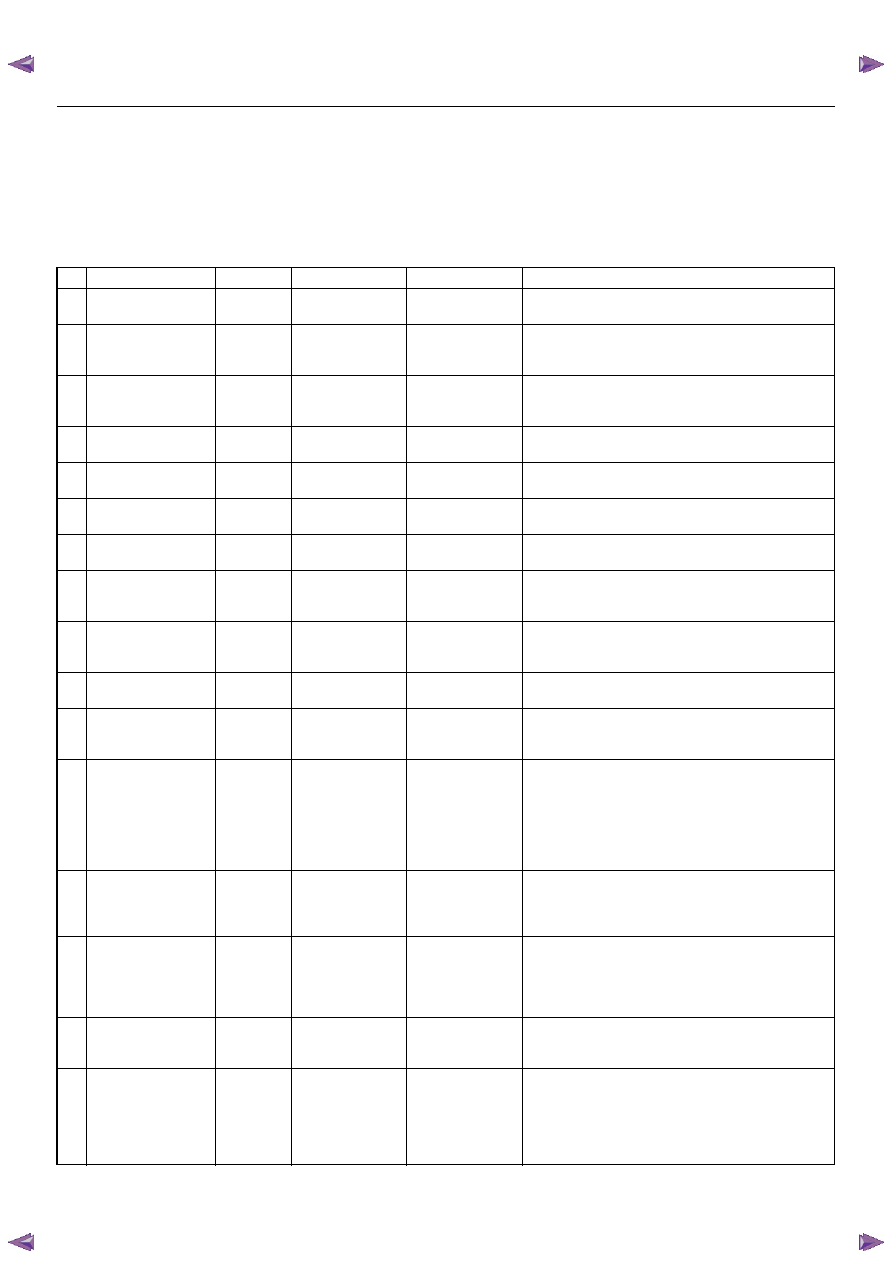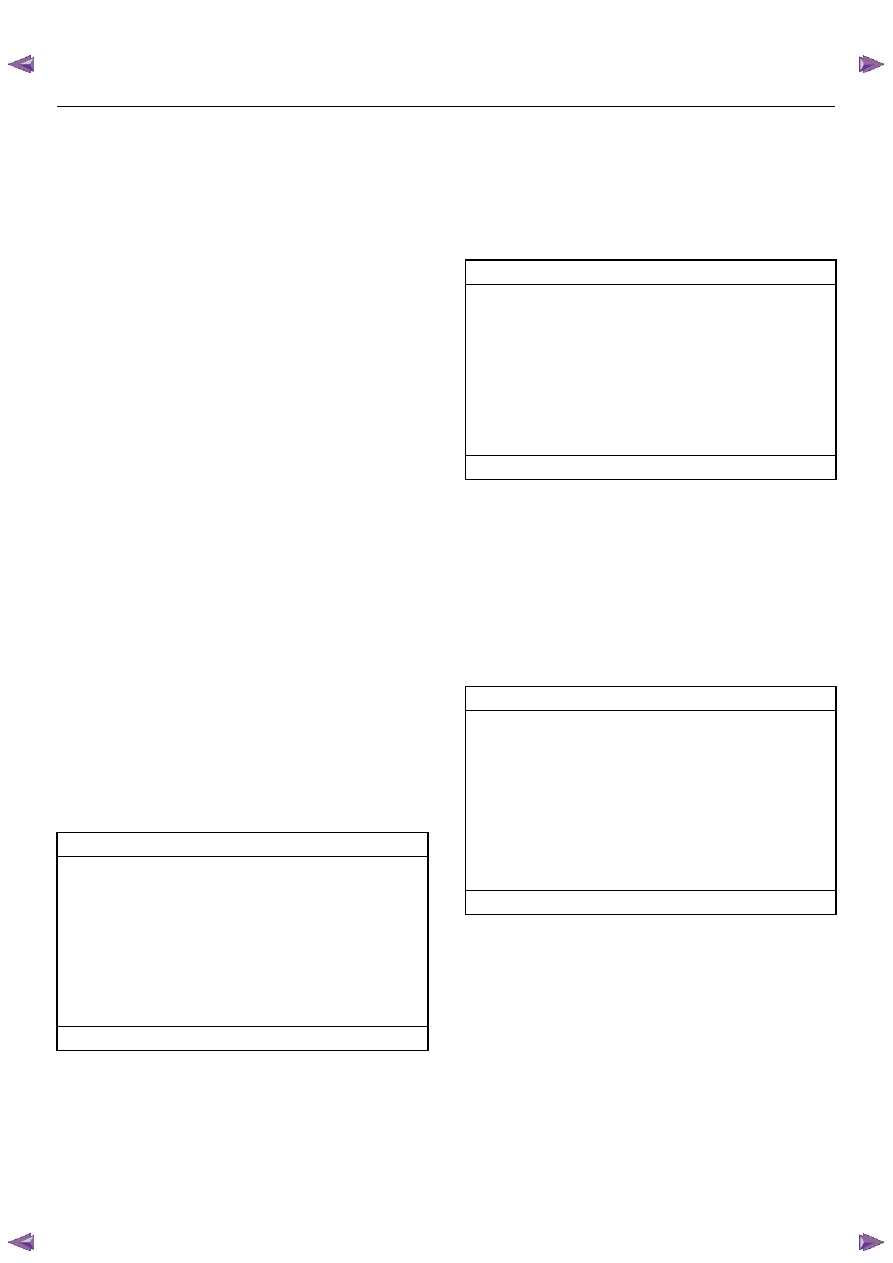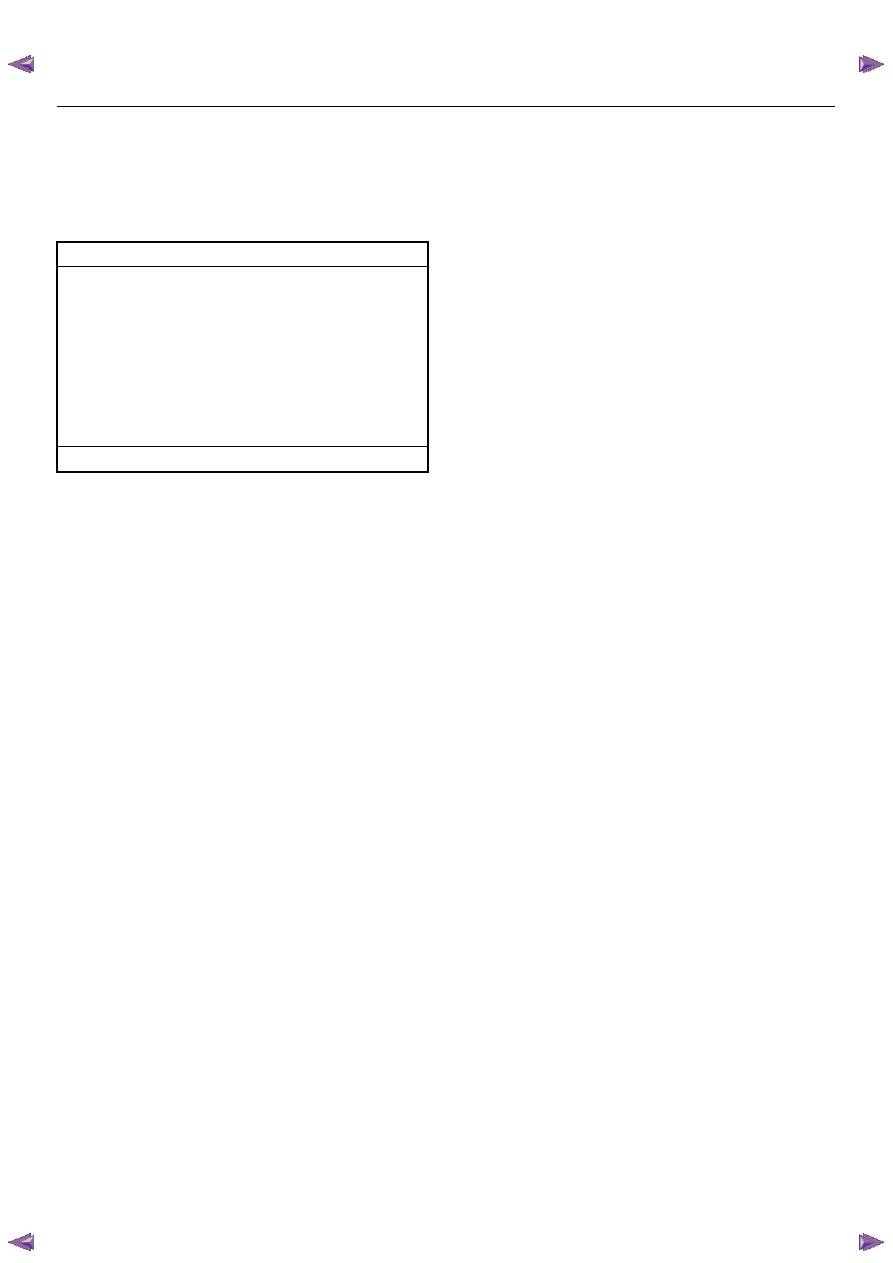Isuzu KB P190. Manual — part 561

6E–74
ENGINE DRIVEABILITY AND EMISSIONS
TYPICAL SCAN DATA & DEFINITIONS (O
2
SENSOR DATA)
Use the Typical Values Table only after the On-Board Diagnostic System Check has been completed, no DTC(s) were
noted, and you have determined that the on-board diagnostics are functioning properly. Tech 2 values from a
properly-running engine may be used for comparison with the engine you are diagnosing.
Condition : Vehicle stopping, engine running, air conditioning off & after warm-up (Coolant temperature approximately
80 deg.)
Tech 2 Parameter
Units
Idle
2000rpm
Description
1
Engine Speed
rpm
710 - 875
1950 - 2050
The actual engine speed is measured by ECM from the
CKP sensor 58X signal.
2
Desired Idle Speed
rpm
825
800
-
850
The desired engine idle speed that the ECM
commanding. The ECM compensates for various engine
loads.
3
Engine Coolant
Temperature
°C or °F
80 - 90
80 - 90
The ECT is measured by ECM from ECT sensor output
voltage. When the engine is normally warm upped, this
data displays approximately 80 °C or more.
4
Start Up ECT (Engine
Coolant Temperature)
°C or °F
Depends on ECT
at start-up
Depends on ECT
at start-up
Start-up ECT is measured by ECM from ECT sensor
output voltage when engine is started.
5
Intake Air
Temperature
°C or °F
Depends on
ambient temp
Depends on
ambient temp
The IAT is measured by ECM from IAT sensor output
voltage. This data is changing by intake air temperature.
6
Start Up IAT (Intake
Air Temperature)
°C or °F
Depends on IAT at
start-up
Depends on IAT at
start-up
Start-up IAT is measured by ECM from IAT sensor output
voltage when engine is started.
7
Manifold Absolute
Pressure
kPa
31 - 36
25 - 30
The MAP (kPa) is measured by ECM from MAP output
voltage. This data is changing by inlet manifold pressure.
8
Barometric Pressure
kPa
Depends on
altitude
Depends on
altitude
The barometric pressure is measured by ECM from the
MAP sensor output voltage monitored during key up and
wide open throttle. This data is changing by altitude.
9
Throttle Position
%
0
2 - 4
Throttle position operating angle is measured by the
ECM from throttle position output voltage. This should
display 0% at idle and 99 - 100% at full throttle.
10
Calculated Air Flow
g/s
3.5 -4.50
8.0 - 10.0
This displays intake air amount. The mass air flow is
measured by ECM from the MAF sensor output voltage.
11
Air Fuel Ratio
14.6:1
14.6:1
This displays the ECM commanded value. In closed
loop, this should normally be displayed around 14.2:1 -
14.7:1.
12
Fuel System Status
Open Loop/
Close Loop
Close Loop
Close Loop
When the engine is first started the system is in “Open
Loop” operation. In “Open Loop”, the ECM ignores the
signal from the oxygen sensors. When various
conditions (ECT, time from start, engine speed & oxygen
sensor output) are met, the system enters “Closed Loop”
operation. In “Closed Loop”, the ECM calculates the air
fuel ratio based on the signal from the oxygen sensors.
13
Engine Load
%
2 - 5
5 - 10
This displays is calculated by the ECM form engine
speed and MAF sensor reading. Engine load should
increase with an increase in engine speed or air flow
amount.
14
B1 O
2
Sensor Ready
(Bank 1)
Yes/No
Yes
Yes
This displays the status of the exhaust oxygen sensor.
This display will indicate “Yes” when the ECM detects a
fluctuating oxygen sensor output voltage sufficient to
allow closed loop operation. This will not occur unless
the oxygen sensor is warmed up.
15
B1S1 Status
(Bank 1 Sensor 1)
Rich / Lean
Rich / Lean
Rich / Lean
This displays dependent on the exhaust oxygen sensor
output voltage. Should fluctuate constantly “Rich” and
“Lean” in closed loop.
16
Fuel Trim Learned
Yes/No
Yes
Yes
When conditions are appropriate for enabling long term
fuel trim corrections, fuel trim learn will display “Yes”.
This indicates that the long term fuel trim is responding
to the short term fuel trim. If the fuel trim lean displays
“No”, then long term fuel trim will not respond to changes
in short term fuel trim.

ENGINE DRIVEABILITY AND EMISSIONS
6E–75
17
Fuel Trim Cell
15 - 20
1 - 2
This displays dependent on engine speed and calculated
intake air flow reading. A plot of engine speed versus
intake air flow amount is divided into the cells. Fuel trim
cell indicates which cell is currently active.
18
B1S1 O
2
Sensor
(Bank1 Sensor 1)
mV
50 - 950
50 -950
This displays the exhaust oxygen sensor output voltage.
Should fluctuate constantly within a range between
10mV (lean exhaust) and 1000mV (rich exhaust) while
operating in closed loop.
19
B1 Short Term Fuel
Trim (Bank 1)
%
-6 - 0
-6 - 0
The short term fuel trim to a bank represents a short term
correction to the bank fuel delivery by the ECM in
response to the amount of time the bank fuel control
oxygen sensor voltage spends above or below the
450mV threshold. If the oxygen sensor voltage has
mainly remained less than 450mV, indicating a lean air/
fuel, short term fuel trim will increase into the positive
range above 0% and the ECM will pass fuel. If the
oxygen sensor voltage stays mainly above the threshold,
short term fuel trim will decrease below 0% into the
negative range while the ECM reduces fuel delivery to
compensate for the indicated rich condition. Under
certain conditions such as extended idle and high
ambient temperatures, canister purge may cause short
term fuel trim to read in the negative range during normal
operation. Fuel trim values at maximum authority may
indicate an excessively rich or lean system.
20
B1 Long Term Fuel
Trim (Bank 1)
%
-10 - 0
-5 - 0
The long term fuel trim is delivered from the short term
fuel term values and represents a long term correction of
fuel delivery for bank in question. A value of 0% indicates
that fuel delivery requires no compensation to maintain
the ECM commanded air fuel ratio. A negative value
indicates that the fuel system is rich and fuel delivery is
being reduced (decreased injector pulse width). A
positive value indicates that a lean condition exists and
the ECM is compensating by add fuel (increased injector
pulse width). Because long term fuel trim tends to follow
short term fuel trim, a value in the negative range due to
canister purge at idle should not be considered unusual.
Fuel trim values at maximum authority may indicate an
excessively rich or lean system.
21
Injection Pulse Width
ms
3.0 - 1.0
3.0
-
4.0
This displays the amount of time the ECM is
commanding each injector On during each engine cycle.
A longer injector pulse width will cause more fuel to be
delivered. Injector pulse width should increase with
increased engine load.
22
Power Enrichment
Yes/No
No
No
The ECM provides the extra amount of fuel when it
detects a rapid increase in the throttle position and air
flow (Power Enrichment). Under this condition the ECM
should detect a “rich condition (high oxygen sensor
voltage).
23
Deceleration Fuel
Cutoff
Active/
Inactive
Inactive
Inactive
The ECM reduces the amount of fuel injected when it
detects a decrease in the throttle position and the air
flow. When deceleration is very fast, the ECM may cut off
fuel completely. Until enable conditions meet the engine
revolution less than 1000rpm or MAP less than 10kPa.
24
Time From Start
-
-
This displays the engine time elapsed since the engine
was started. If the engine is stopped, engine run time will
be reset to 00:00:00
Tech 2 Parameter
Units
Idle
2000rpm
Description

6E–76
ENGINE DRIVEABILITY AND EMISSIONS
MISCELLANEOUS TEST
The state of each circuit can be tested by using
miscellaneous test menus. Especially when DTC
cannot be detected, a faulty circuit can be diagnosed by
testing each circuit by means of these menus.
Even DTC has been detected, the circuit tests using
these menus could help discriminate between a
mechanical trouble and an electrical trouble.
Connect Tech 2 and select “Powertrain”, “2.XL L4
HV240” & “Miscellaneous Test”.
F0: Lamps
F0: Malfunction Indicator Lamp
When the Tech 2 is operated, “Malfunction Indicator
Lamp (Check Engine Lamp)” is turned on or off.
The circuit is normal if the “Malfunction Indicator Lamp
(Check Engine Lamp)” in the instrument panel is turned
on or off in accordance with this operation.
F1: Relays
F0: Fuel Pump Relay
When the Tech 2 is operated, fuel pump relay signal
turns ON or OFF.
The circuit is normal if fuel pump sound is generated in
accordance with this operation when key switch is
turned ON.
F1: A/C Clutch Relay
When the Tech 2 is operated, A/C clutch relay signal
turns ON or OFF.
The circuit is normal if A/C compressor clutch is
energized in accordance with this operation when the
engine is running.
F2: EVAP
F0: Purge Solenoid
When the Tech 2 is operated, duty ratio of EVAP purge
solenoid is changed 10%-by-10%.
• Press “Increase” key.
Then, EVAP Purge Solenoid is increases 10%-by-
10%.
• Press “Quit” Key.
F3: IAC System
F0: IAC Control
When the Tech 2 is operated, “Idle Air Control”
increases or decreases 5steps-by-5steps up to
150steps.
The circuit is normal if idle engine speed is changed in
accordance with this operation.
• Press “Increase” key.
Then, Idle Air Control is increases 1osteps-by-
10steps up to 160steps. Engine speed is also
changed by this operation.
• Press “Quit” Key.
F1: IAC Reset
When the Tech 2 is operated, “Idle Air Control” resets.
The circuit is normal if idle engine speed is droped in
accordance with this operation.
• Press “Increase” key.
Then, Desired Idle speed is increases 50rpm-by-
50rpm up to 1550rpm. Engine speed is also changed
by this operation.
• Press “Quit” Key.
Purge Solenoid
Engine Speed
800 RPM
Desired Idle Speed
762 RPM
Engine Coolant Temperature
80 °C
Start Up ECT
50 °C
Intake Air Temperature
30 °C
Start Up IAT
25 °C
Manifold Absolute Pressure
35kPa
EVAP Purge Solenoid
30%
IAC Control
Engine Speed
800 RPM
Desired Idle Speed
762 RPM
Engine Coolant Temperature
80 °C
Start Up ECT
50 °C
Intake Air Temperature
30 °C
Start Up IAT
25 °C
Manifold Absolute Pressure
35kPa
Idle Air Control
30 Steps
IAC Reset
Engine Speed
800 RPM
Desired Idle Speed
762 RPM
Engine Coolant Temperature
80 °C
Start Up ECT
50 °C
Intake Air Temperature
30 °C
Start Up IAT
25 °C
Manifold Absolute Pressure
35kPa
Idle Air Control
30 Steps

ENGINE DRIVEABILITY AND EMISSIONS
6E–77
F4: Injector Balance Test
When the Tech 2 is operated, selected injector turns ON
or OFF.
The circuit is normal if engine vibration is changed at
selected cylinder in accordance with this operation
when engine is idling.
• Press “Injector Off” key.
Then, engine speed drops and vibration occurs when
a cylinder is selected.
• Press “Quit” Key.
Injector Balance Test
Engine Speed
800 RPM
Desired Idle Speed
762 RPM
Engine Coolant Temperature
80
Start Up ECT
50
Intake Air Temperature
30
Start Up IAT
25
Manifold Absolute Pressure
35kPa
Injector 1
On

Нет комментариевНе стесняйтесь поделиться с нами вашим ценным мнением.
Текст